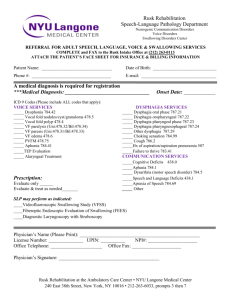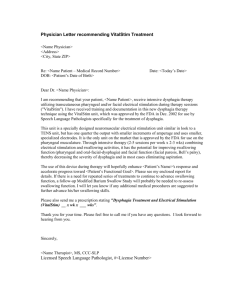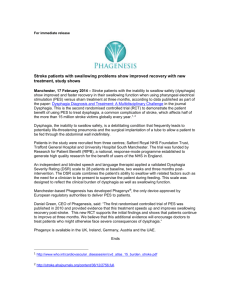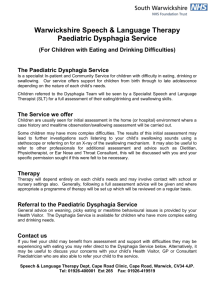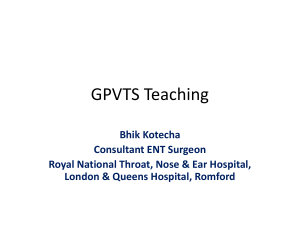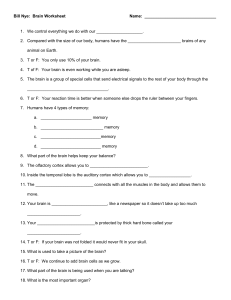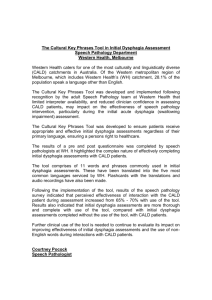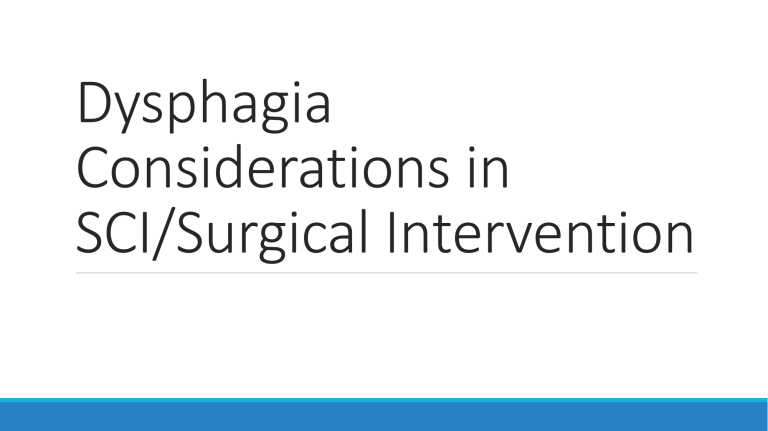
Dysphagia Considerations in SCI/Surgical Intervention At Risk Population Incidences of transient dysphagia range from 35-50% peri-op. in millennium studies. About 10% may continue to have dysphagia at long-term Females Age >60 years Undergoing multilevel surgery Pre-existing swallowing dysfunction are especially at risk Study Fogel, G. R., and McDonnell, M. F.(2005)Surgical treatment of dysphagia after anterior cervical interbody fusion. Spine J, 5(2): 140-4. Surgical Treatment of Dysphagia After ACIF Fogel and McDonnell (2005) Hypothesized: removal of the anterior cervical plate would release adhesions of the esophagus to prevertebral fascia and anterior C-spine. Pre-op 31 patients: 15 had moderate dysphagia, 16 had severe dysphagia Post-op at 1, 6, 12 months: ◦ 17 no dysphagia, 10 mild dysphagia associated with specific foods, 3 moderate dysphagia with solids, 1 persistent severe dysphagia with solids & liquids Surgical treatment of dysphagia is a reasonable option given dissatisfaction prior to treatment. Loose Anterior Fixation Plate Screw Possible Complications from ACIF/ACDF Hematoma – collection of blood from vascular damage forms a mass, compression of pharynx, cervical esophagus, obstructing laryngeal inlet Edema – decreased pharyngeal wall movement, impaired UES opening, incomplete epiglottic inversion, and vallecular, pyriform sinus, and posterior pharyngeal wall stasis Possible Complications (cont’d) Infection – Bacterial contamination or inadvertent perforation of pharynx producing necrosis and spillage from digestive tract Denervation – Pharyngeal plexus comprised of branches of the glossopharyngeal and vagus nerves Dysphagia and SCI/Surgery Anatomy of at-risk structures: ◦glossopharyngeal and hypoglossal (impaired lingual propulsion) nerves C3 or above ◦superior laryngeal nerve at C3-C4 (absent pharyngeal swallow) ◦ Vagus nerve and recurrent laryngeal nerve at C6 or below ◦Vagal input innervates upper esophageal region Prevertebral Soft Tissue Edema Kang et al. 2016 Prospective Study https://www.ncbi.nlm.nih.gov/pmc/articles/PMC510 2869/ Highest surgery level at C3 and C4 showed more abnormal VFSS results: significantly increased soft tissue thickness and decreased maximal UES opening distance. Post-op Dysphagia Symptoms Symptoms reported: ◦ Odynophagia ◦ Dysphagia with saliva (difficulty managing oral secretions) ◦ Heartburn ◦ Coughing or choking with swallowing ◦ Regurgitation ◦ Feeling of blockage ◦ Frequent or delayed throat clearing ◦ Wet voice quality ◦ Vocal hoarseness Dysphagia Due to Cervical Spine Surgery STUDY BY WELSH ET AL., OTORHINOLARYNGOLOGY JOURNAL; 1987. Findings Persistence of dysphagia symptoms >48 hours should alert physician to possible regional complications 5 patients studied demonstrated improved swallowing function ranging 8-15 days. Superimposed febrile illness strongly implies infection, warranting management Caveats for infection following bone mass injection ◦ Injections at C6 and above are at higher risk for pharyngeal perforation and contamination ◦ Relatively lateral position of pharyngeal wall Disorders of Social Cognition EXCERPTS FROM MCDONALD ET AL. TEXT - CHAPTER 5 Disorders of Social Cognition Attend to, recognize, interpret interpersonal cues Help understand and predict behaviors Share experiences and effectively communicate Damage to orbito-ventral and medial frontal lobes (Contrast to non-social cognition – dorsal areas of lateral and medial prefrontal cortex) Functions of the orbitofrontal cortex http://www.oxcns.org/papers/357_Rolls04.pdf Secondary Effects Wallerian degeneration: deterioration of downstream structures that become disconnected to structures at lesion sites. 40-50% suffer expansion of initial contusions during acute phase (Change et al., 2006) DAI to brainstem – increased likelihood of impaired social cognition Deficits in Social Cognition Emotional processing: emotional perception and empathy Mental judgements: infer intentions and beliefs of others and see other POV; theory of mind (ToM; Baron-Cohen et al., 1994) Predict behavior of others Static Vs. Dynamic Facial Expressions Babbage et al., 2011 in a meta-analysis of 296 people with TBI from 13 studies Up to 39% of people with severe TBI had difficulty recognizing static facial expressions and their emotional associates. Dynamic is yet more difficult – ever changing Increased processing demand and mental flexibility Vocal Perception Recognizing vocal emotions Deficits in recognition of facial expressions and vocal recognition can co-occur or be independent of each other Affected by slowed processing Fear, disgust, sadness, and anger are less perceptible by patients after TBI Limbic structures and ventromedial frontal lobes rapidly detect ambiguous events that have emotional context. Amygdala – detects fear, sadness, anger; detects danger Empathy 60-70% lack empathy as compared to 30% matched adult controls. (de Sousa et al., 2012) 50% self-reported lack of empathy as compared to 18% controls. Significant relationship between self-reported lack of empathy and impaired emotional mimicry (imitation) to negative facial expressions (de Sousa et al., 2010). Empathy Mimicry may have more relation to our empathetic response to others than it does to emotional perception. Self-awareness and self-regulation are important in empathic process to recognize self from others (Decety & Meyer, 2008). Pedantic – Emphasis on formalities; points out corrections in unimportant details; perfectionistic, meticulous, fastidious Disorders of Emotional Regulation Disorders of Control or Drive are common after TBI Commonly associated with executive skills impairment Important in managing emotional behavior and decision making. Disorders of Control •Impulsivity •Disinhibition (recall inhibitory and interference control) •Inappropriate levels of self-disclosure •Irritability •Poor frustration tolerance •Emotional lability •Aggression •Childlike affect •Sexual disinhibition Disorders of Drive ◦Apathy/Aspontaneity (medial & dorsal frontal lobes connected to thalamus and reticular formation) ◦Egocentrism/Self-focused ◦Lack of interest in others/Indifference ◦Poor mental flexibility ◦ Adynamia – a rigid, uncompromising, inflexible thinking “black & white” Indifference Decreased responsivity to others or environmental events ◦ adversely impacts a person’s emotional experience and complex decision making. A patient with an orbitofrontal lesion, intact memory and aboveaverage intelligence, exhibited poor social conduct. Sociopathy – associated with damage to prefrontal cortex consequently showed impaired activation of somatosensory system (postfrontal cortex) necessary “to understand the implications of poor social decisions”. (Damasio et al., 1990). Social Cognition These skills are critical for successful interpersonal interactions. Social Dysfunction in Children & Adolescents Social Skills Children tend to rate social skills highest in priority unlike their parents. Reports estimate 10% of children are affected by social dysfunction Higher risk in TBI, 50% Social Skills Disruptions in development may cause ◦Psychological distress ◦Poor self-esteem ◦Feel different ◦Fatigue – poor motivation and endurance ◦Social anxiety ◦Social Isolation/Withdrawal Factors Impacting Social Skills Important for social function: biological models, environment & experience Overprotective parents or parental restrictions may limit social opportunities. TBI can result in physical, cognitive, communicative, behavioral problems, and poor academic skills. (Anderson et al., 2009) Social Competence Achieve personal goals in social settings while maintaining positive relationships Social Interaction Modify social actions/reactions between persons or groups Social Adjustment Adapt to changes or demands in a social environment Poor Social Outcomes Poor social skills increase risk for delinquent, criminal behavior, aggression, violence, disorders of conduct, bullying, or sexual offenses 35% of incarcerated juveniles had TBI (Kenny & Jennings, 2007) 87% of adult prisoners had TBI (Butler et al., 2003) Maternal attachment and parent-child interactions contribute to long term social outcomes. Social Skills Development Infancy begins recognition of emotion in faces and in voice Adolescent brain undergoes significant neurostructural changes • Decreased gray matter volume and increased white matter density in frontal and parietal lobes (Casey et al., 2005) SS mediated by social-affective and cognitive-executive processes (Yeates et al., 2007) Lower SES associated with poor adjustment and peer misconduct (Bulotsky-Shearer et al., 2008) This population is at a greater social disadvantage. Review pp. 165-166 on Neural Bases of Social Cognition and Function Neural Bases of Social Cognition Facial Recognition – fusiform gyrus and superior temporal sulcus Emotion Perception – amygdala, insula, and ventral striatum Higher-order social skills – frontal cortex (upcoming slide) Theory of Mind (ToM) – medial prefrontal cortex, superior temporal sulcus, temporo-parietal junction, and temporal poles Empathy – mirror neuron system*, anterior cingulate cortex, regions of somatosensory cortex and anterior insula Moral reasoning – prefrontal regions, temporo-parietal junction Mirror Neurons Acharya, S. & Shukla, S. (2012).Mirror neurons: Enigma of the metaphysical modular brain. J Nat Sci Biol Med. 2012 Jul-Dec; 3(2): 118–124. Found: premotor cortex, supplementary motor area, primary somatosensory cortex, and inferior parietal cortex Mirror Neurons Mirror Neurons Cognitive Domains for Social Skills 3 higher-order cognitive domains are necessary for social function ◦Attention and executive skills ◦interventions improve self-regulation, problem solving & social competence Cognitive Domains cont’d ◦Communication ◦ Comprehension ◦ Pragmatics ◦ Social skills progress quickly as expressive language emerges. ◦Social Cognition ◦ modulate appropriate behavior in social context ◦ ToM attributing mental states (beliefs, intents, desires, pretending, knowledge) to oneself and others and understand another’s mental state may differ ◦ “mental empathy”
